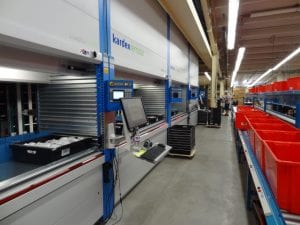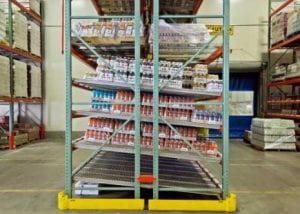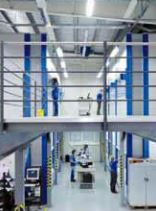You’ve decided that automating the storage, picking, and kitting of your material is something you want to pursue but now need to determine how

5 questions to answer when determining if an AS/RS is right for your operation
- What material is a good candidate for automated storage/picking?
Within your mix of SKUs, you have very fast-moving products that you pick numerous times per day, and possibly in large volume, all the way to very slow-moving product that you may only pick once per week or less. Let’s rank the popularity of your SKUs from A to D with A being the fastest moving SKUs and D being the slowest. An AS/RS is best suited to your B’s and C’s. Your A’s move so fast that it could be a hindrance to productivity as you would need to replenish those locations too often. Your D’s aren’t suited to an AS/RS either as their movement is so slow that they would simply take up valuable storage locations.
What we typically see within an AS/RS pick module is the A’s positioned on flow racks next to the AS/RS. This set up allows multiple pickers

- How many orders/lines do I pick on an hourly basis?
Most AS/RS offer tremendous storage efficiencies as they allow you to utilize your vertical cube for storage density. But storage density and reclaiming floor space are but one aspect to consider. For most operations, when it’s crunch time and you need to get orders out the door or kits to manufacturing, they throw bodies at the problem and enlist the help of many pickers to get the job done.
An AS/RS’s productivity is metered by the number of pick stations designed into the system. A proper evaluation and analysis not only take into consideration how much floor space you’re saving but also needs to incorporate your throughput needs- both now and in the future.
- Do I weigh, bag and tag any of my SKUs?
When we talk about an AS/RS, we typically talk about the ability to deliver SKUs to the pick window in the neighborhood of 150 – 250 SKUs per hour. When you have an operation that needs to weigh count a certain percentage of your picks, it grinds productivity to a halt. Between retrieving the part, determining the tare weight, getting an accurate count, printing and applying the label, and then returning the SKU to its storage location can take as long as two minutes per pick. Two minutes per pick for a weigh–bag–tag operation calculates to 30 lines per hour. The percentage of your picks that require a weigh–bag–tag process can have a compounding impact on productivity and need to be taken into consideration when determining throughput expectations.
- Where do I start to determine if automating the storage, picking, and kitting of my material is justifiable?
The first step in the process is to perform a cube analysis of all the material you would like stored within your AS/RS. The professional performing the cube analysis will look at your current SKU locations to determine the cube and weight of those SKUs. This information is entered into a program that ultimately determines the cube or volume of the material you’re looking to store.
- Physical location of the system – How much vertical height is there?


Justify an AS/RS for your operation
Contact a reputable systems integrator like Abel Womack to start the conversation. If reclaiming floor space for more revenue generating operations along with increased speed and accuracy of picking is something your operation is looking for, one of our specialists can help you decide if an AS/RS might be for you.



Leave a Reply
You must be logged in to post a comment.